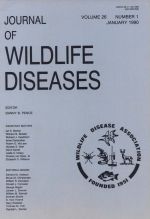Seasonality and impact of parasitism by the larvae of Rogenhofera bonaerensis (Diptera: Cuterebridae) in pampean grassland mouse (Akodon azarae, Rodentia, Cricetidae) populations were studied in grasslands and cropfield borders near Diego Gaynor (Buenos Aires Province, Argentina), from November 1985 to December 1986. Trapped mice infections ranged from one larva (77%) to four (4%) per host; larvae occured on tails (75.7%), backs (17.1%), thighs (5.7%), and abdomen (1.4%). Prevalence of larvae occurred in late spring (November and December) (35%), and in fall (March to June) (20%), with a peak of 25% during April and May. In spring these larvae affected 46% of resident and 19% of transient individuals; however, no differences were found between residents and transients in spring or fall. There was no significant relationship between mouse population density and prevalence of parasitism (r = −0.56). The annual percentage of infected rodents changed with age (body size classes): adults (37%) > subadults (25%) > juveniles (16%); with no differences between the sexes. Similar results were recorded in the spring, but there were no differences in the fall. Significant differences were not detected between stable (22% infected) and disturbed habitats (14% infected). During winter uninfected mice survived better than those infected during the previous fall. In contrast, the summer survival among spring infected mice and noninfected mice was similar. Parasitism showed no effects on reproductive activity and on home range size. Larvae showed strong host specificity for A. azarae (99%). Only one case was recorded in the long-tailed mouse (Oligoryzomys flavescens), and none in the white paunch mouse (Calomys laucha), both species sympatric with A. azarae. This suggests that the pampean grassland mouse is essential for perpetuation of this bot fly as a result of a coevolutionary process within the grassland rodent assemblage. According to the A. azarae population dynamics the bot fly strategy could be adjusted to an opportunist pattern.
How to translate text using browser tools
1 January 1990
BOT FLY PARASITISM (ROGENHOFERA BONAERENSIS) (DIPTERA, CUTEREBRIDAE) IN THE PAMPEAN GRASSLAND MOUSE (AKODON AZARAE), IN ARGENTINA
Gustavo A. Zuleta,
María Laura Vignau

Journal of Wildlife Diseases
Vol. 26 • No. 1
January 1990
Vol. 26 • No. 1
January 1990
Akodon azarae
bot fly
Cuterebridae
ecology
home range
Host-parasite relationship
impact of parasitism




